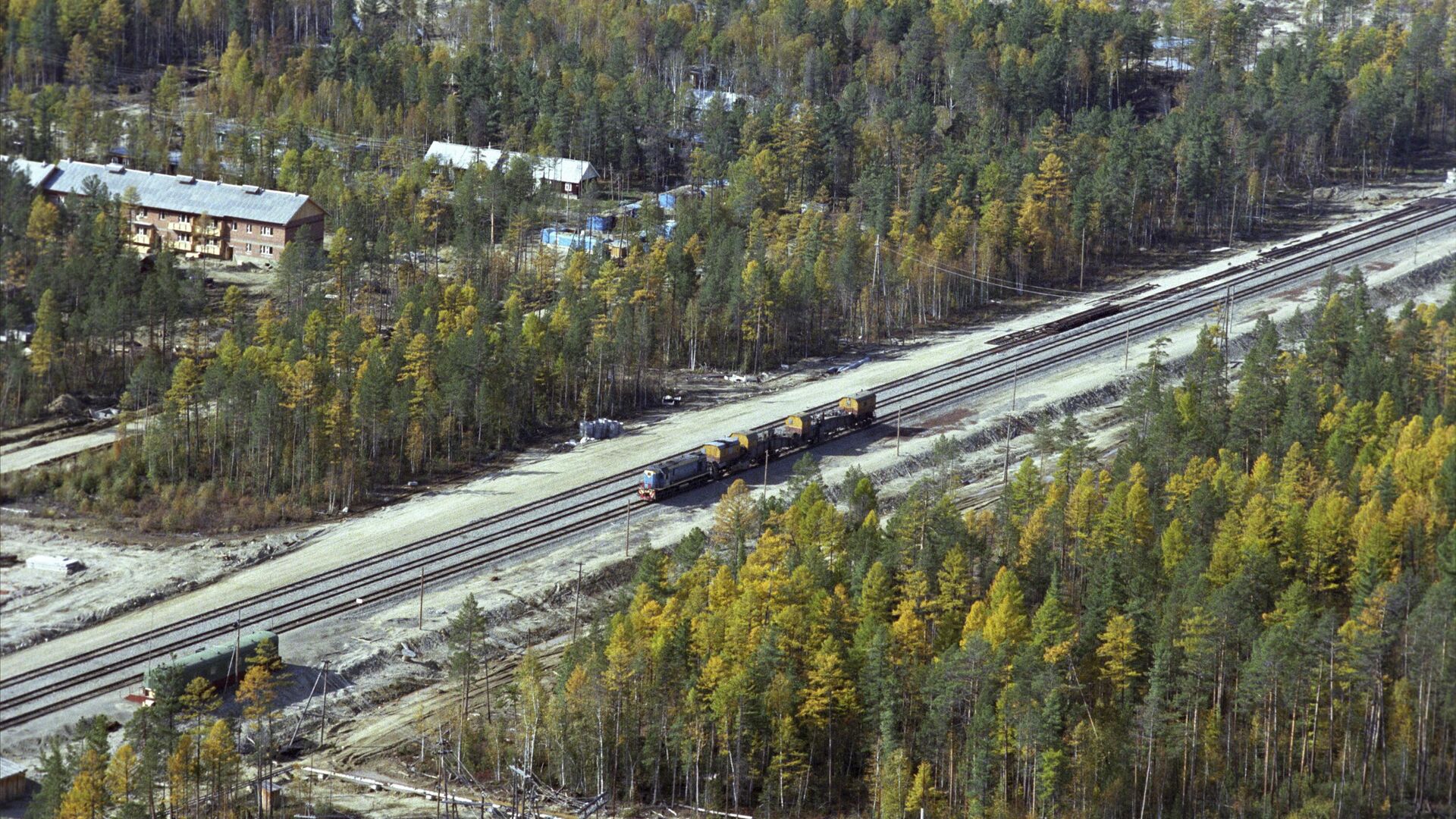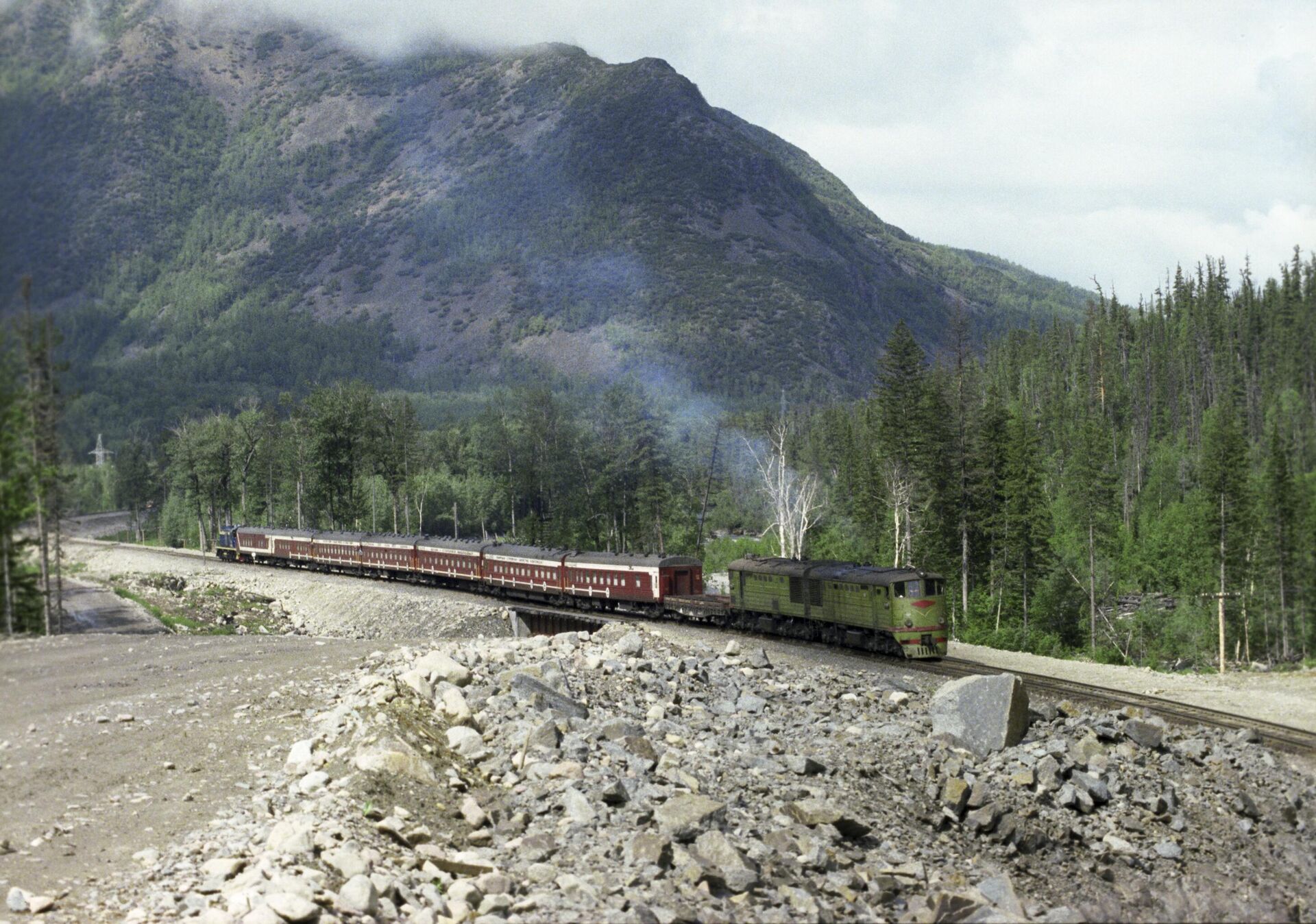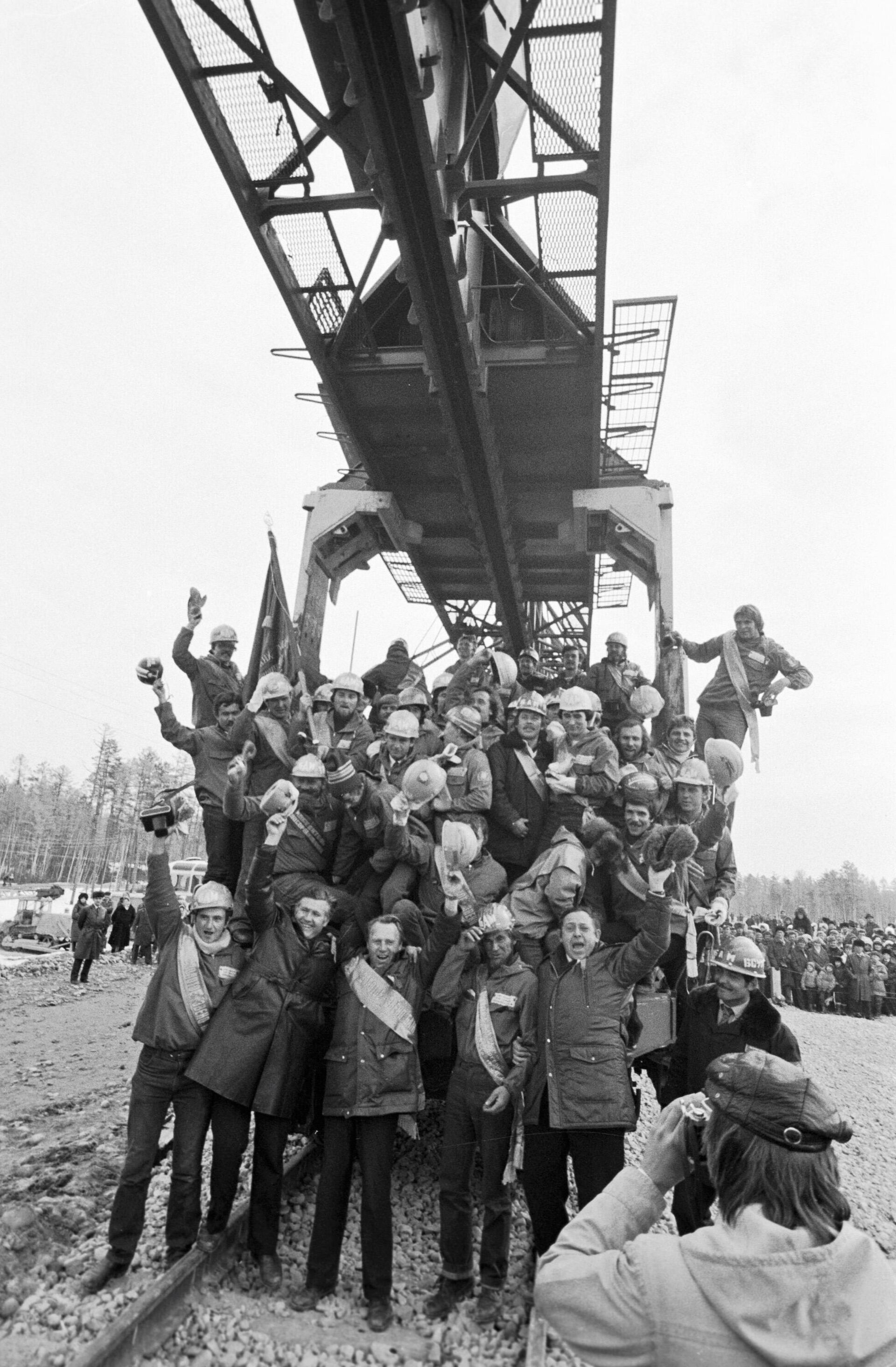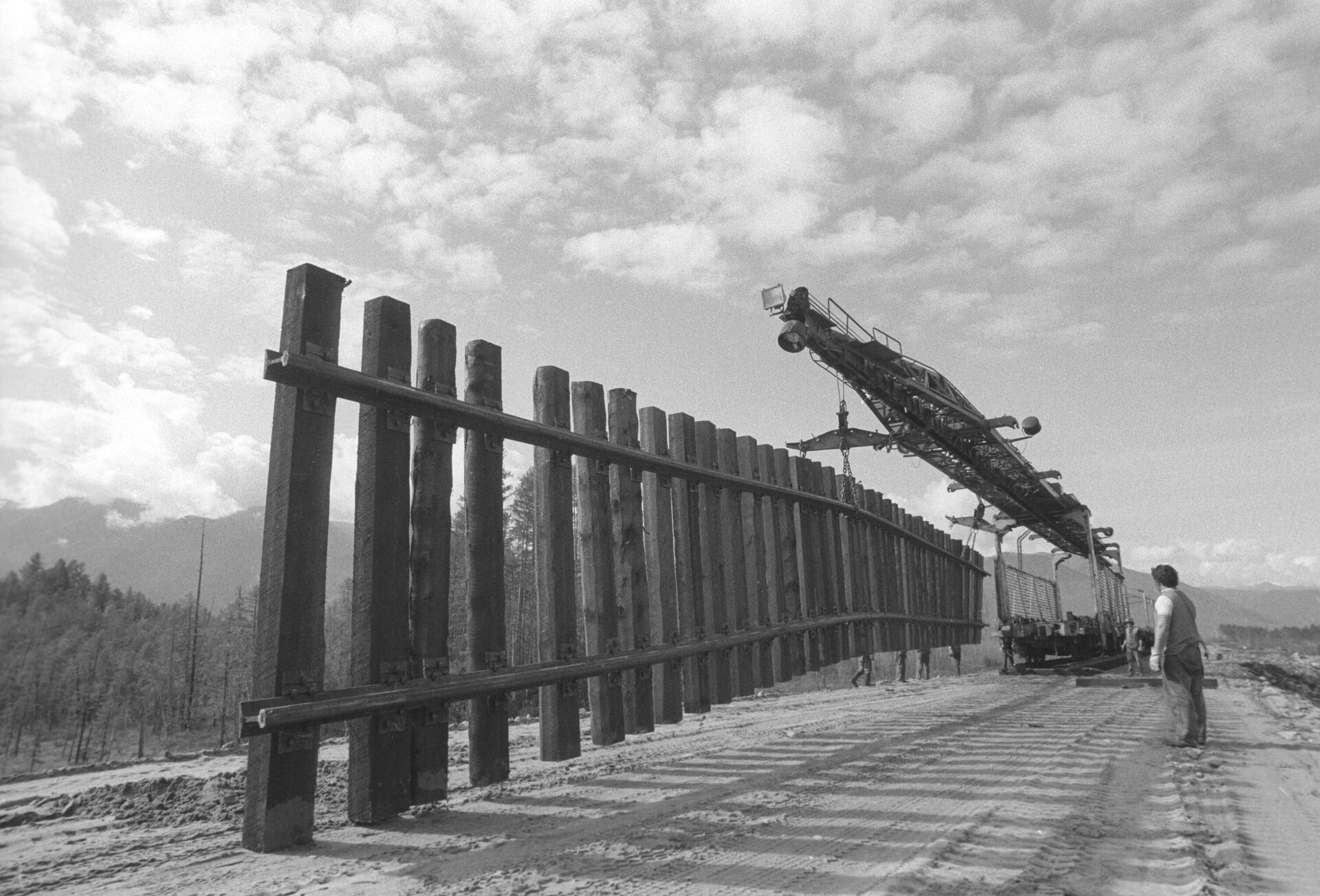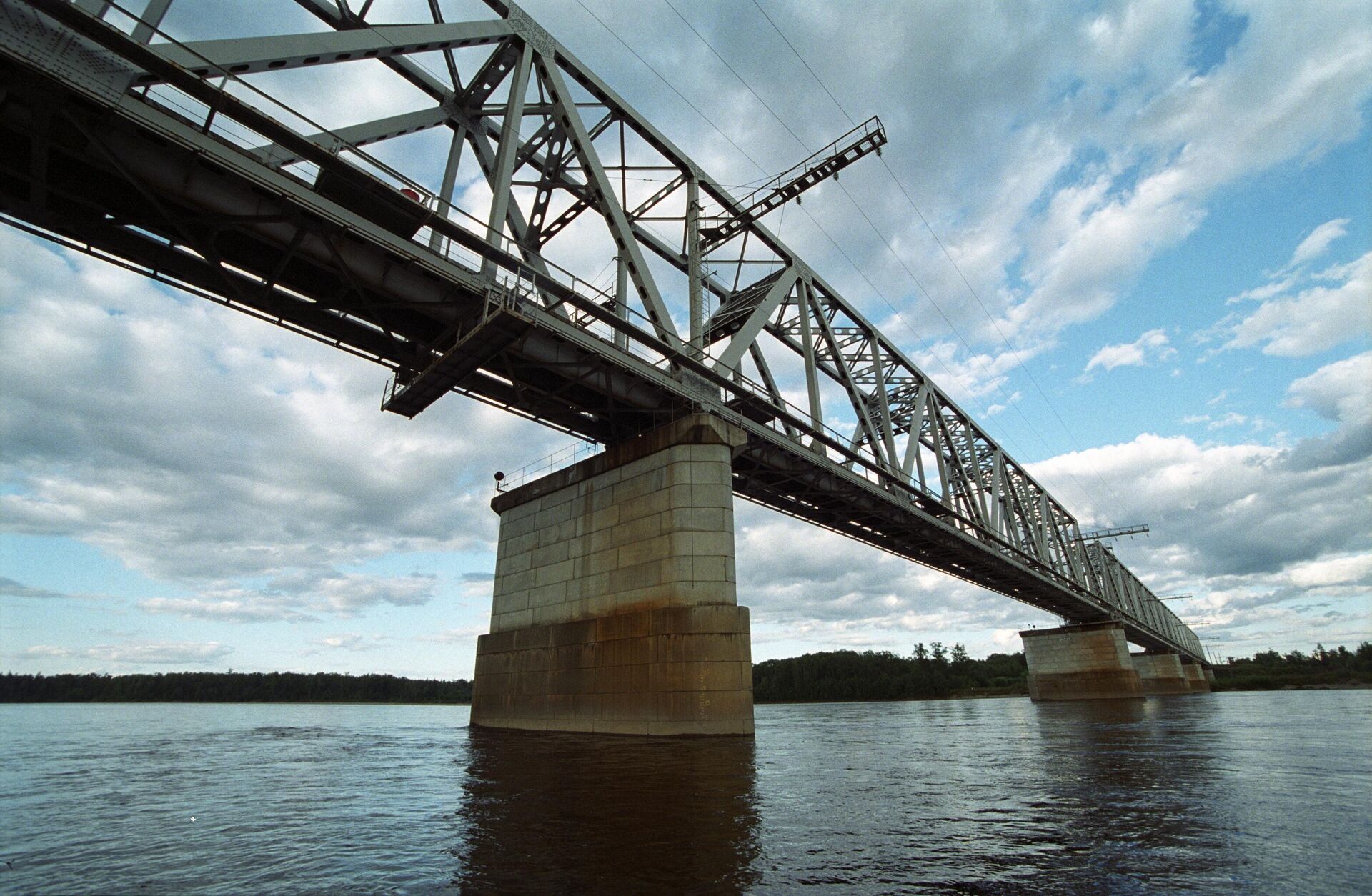https://sputnikglobe.com/20240423/russias-baikal-amur-mainline-future-center-of-global-development-1118071555.html
Russia's Baikal-Amur Mainline Future 'Center of Global Development'
Russia's Baikal-Amur Mainline Future 'Center of Global Development'
Sputnik International
Baikal-Amur Mainline (BAM) is where the center of global development will be in the future, Associate Professor of the Academy of Labor and Social Relations Pavel Feldman told Sputnik.
2024-04-23T17:17+0000
2024-04-23T17:17+0000
2024-04-23T17:17+0000
analysis
russia
trans-siberian railway
russian railways
baikal
vladimir putin
pacific
baikal-amur mainline
northern sea route
https://cdn1.img.sputnikglobe.com/img/07e8/04/17/1118070529_0:181:2997:1867_1920x0_80_0_0_b2c7f9771ad3e2bdf7af06a1df2f0db9.jpg
Russia’s Baikal-Amur Mainline (BAM) from Europe to the Pacific is “where the center of global development will be in the future,” Associate Professor of the Academy of Labor and Social Relations Pavel Feldman told Sputnik.On the anniversary of the BAM, Feldman stressed that the entire concept of the route corresponds to the unique geopolitical position of Russia.“The BAM is not just a railway, but the most important factor in ensuring the territorial integrity and national security of the Russian Federation,” said the Deputy Director of the Institute of Strategic Studies and Forecasts of RUDN University.The BAM’s key economic and strategic importance is a proven fact, agreed veteran Russian military expert Ivan Konovalov. Current reality shows that this was "an epic, far-sighted, long-term project," he said.From a strategic aspect, the BAM was built to offer an alternative to the Trans-Siberian Railway, which runs close to Russia's south-eastern borders.“Already then, before WWII, there were serious contradictions with Japan... So it was decided to move this mainline deeper into Russian territory. In some places, the BAM is 700 to 1000 kilometers away from the border, which is a serious strategic depth,” he said.According to the military expert, that Russia’s armed forces have always been involved in the mainline project. He recalled that two army railway corps were involved in developing the difficult terrain.“They have the equipment and specialists for this, and most importantly, a clearly structured management vertical, which allows them to quickly resolve complex issues quickly ensuring a successful outcome,” he notedHere are some eye-opening facts & figures about the BAM.Project of Epic ScaleAs well as providing a strategic alternative route to the Trans–Siberian Railway to transport freight to the Pacific ports, the BAM also aimed to help tap into rich deposits of iron, coal, copper, gold and diamonds in the pristine remote regions.The first survey work along this route began in 1911, with construction getting underway in the 1930s. Working in a remote land that was barely inhabited, less than a thousand kilometers away from the Arctic circle and across permanently frozen subsoil was a huge challenge. It continued in spurts, with the outbreak of WWII putting the project on hold. Some of the tracks were pulled up, with rails re-used in the European part of Russia during the war to lay new railways. The mainline was a very important logistics route for supplying Red Army soldiers.The BAM in the form in which we know it today was constructed in the 70s, Pavel Feldman noted.On April 23, 1974, the Baikal-Amur Mainline was proclaimed an All-Union project. Hundreds of thousands of students in construction brigades and volunteers from across the country joined the epic effort. The most challenging and remote sections were built by railway troops. It took 12 years to build the main section of the railroad between 1972 and 1984.Vast Transit Potential The BAM is a “key pillar of the development of the Russian economy in the eastern direction,” economist and leading expert at Russia’s Center for Political Technologies Nikita Maslennikov told Sputnik.The reasons for Russia’s pivot to the Asia-Pacific region in general are clear, he noted.Russia’s Far East, especially its Primorye territory, offers huge expanses of rich reserves of minerals. Tapping into this wealth requires transport logistics. The BAM is intertwined with goals such as development of these territories and integration into the Asia-Pacific region, an “economic space, which will dominate the world economy as a whole for the next half century,” said the expert.The BAM, together with the Trans-Siberian Railway that crosses the entire territory of Russia, has become an important tool for solving economic problems linked with transporting goods, remarked Konovalov.He recalled that the Ukraine crisis and the West's self-harming sanctions on Russia, the raging Middle East crisis, Israel’s war on Hamas and Yemen's partial blockade of the Red Sea in solidarity with Gaza have all brought economic fallout.“Unless I am mistaken, the tariffs for sea cargo transportation have jumped about five times." said Konovalov. "And here we are solving a very important problem, using the Baikal-Amur Mainline, taking into account the fact that we also have the Northern Sea Route, which, with climate warming, also creates a unique opportunity for the Russia to operate the kind of global communication network that all global powers hope to take advantage of.”Rapid economic growth the Asia-Pacific region countries over the last decade radically redirected international trade flows, including Russian trade. Over the past 20 years, the total share of Asian markets in exports from Russia has increased, according to some estimates, from 27 percent to 40 percent.Take coal as an example. Over the past two decades, global coal consumption has been steadily shifting towards Asian markets. European countries have set themselves the task of reducing fossil fuel reliance, not to mention the fact the EU introduced a complete ban on the purchase of coal from Russia as part of the short-sighted Western sanctions.The share of coal supplies to Asian markets, however, increased during this time from around 33 percent to 62 to 64 percent. It was only logical to export coal directly to the east: In 2023, Russia ramped up coal supplies to China almost 1.5 times to an all-time high of more than 100 million tons.According to Feldman, from an economic point of view the BAM blends seamlessly with China’s “one belt, one road” initiative, which will connect the Asian manufacturing base with European consumer markets through a logistics chain.Maslennikov also stressed that it is hard to overestimate the importance of this transport artery for the liquefied natural gas production capacity that is now being actively enhanced in the Far East, oil refining, aircraft manufacturing and shipbuilding.Russia is constantly working to diversify the BAM cargo base. China is also interested in Russian agricultural products, with the corresponding infrastructure such as grain terminals being developed along the BAM route. Russia’s Far East authorities have identified meat, meat products, milk, dairy products, and vegetables as promising agricultural products for export.The BAM is an ongoing project, constantly upgraded by the state-owned Russian Railways company. Works such as laying additional tracks and expanding the number of stations are aimed at relieving existing bottlenecks plaguing both the Baikal-Amur Mainline and the Trans-Siberian Railway.In 2024, a whole series of tourism features will be launched as part of the BAM Tourist project showcasing historical sites, natural attractions and technological features of the railway.
https://sputnikglobe.com/20231018/putin-chinas-belt-and-road-initiative-in-sync-with-russias-ideas-on-large-eurasian-space-1114276570.html
russia
baikal
pacific
Sputnik International
feedback@sputniknews.com
+74956456601
MIA „Rosiya Segodnya“
2024
News
en_EN
Sputnik International
feedback@sputniknews.com
+74956456601
MIA „Rosiya Segodnya“
Sputnik International
feedback@sputniknews.com
+74956456601
MIA „Rosiya Segodnya“
what is bam, where is baikal-amur mainline, how long is baikal-amur mainline, baikal-amur mainline is bam, why is bam a key railway project, how was bam built, how long is bam, what is the route of the why is bam russia’s key railway, does bam link europe to pacific ocean, what cargoes does bam transport, how is bam different from trans-siberian railway, russia's pivot to the east,
what is bam, where is baikal-amur mainline, how long is baikal-amur mainline, baikal-amur mainline is bam, why is bam a key railway project, how was bam built, how long is bam, what is the route of the why is bam russia’s key railway, does bam link europe to pacific ocean, what cargoes does bam transport, how is bam different from trans-siberian railway, russia's pivot to the east,
Russia's Baikal-Amur Mainline Future 'Center of Global Development'
On the 50th anniversary of the Baikal-Amur Mainline (BAM), Russian President Vladimir Putin stressed that it was a railway of the future destined to define global logistics for the 21st century. He added that Russia's pivot towards the east became possible thanks to the BAM.
Russia’s Baikal-Amur Mainline (BAM) from Europe to the Pacific is “where the center of global development will be in the future,” Associate Professor of the Academy of Labor and Social Relations Pavel Feldman told Sputnik.
“The land route leading from Europe to Pacific ports opens a window into the Asian economic space for Russia and its partners," Feldman noted "The reorientation of our country to the East is turning from a ‘futuristic concept’ into an inevitable scenario for the development of events.”
One of the longest railways in the world — Russia’s Baikal-Amur Mainline — is celebrating its 50th anniversary. The unprecedented civil engineering project spanning decades was conceived as a strategic alternative route to the Trans–Siberian Railway and gave the country its second outlet to the Pacific Ocean. Its role in the economy of Russia and countries of the Asia-Pacific region is increasingly gaining clout.
On the anniversary of the BAM, Feldman stressed that the entire concept of the route corresponds to the unique geopolitical position of Russia.
“The BAM is not just a railway, but the most important factor in ensuring the territorial integrity and national security of the Russian Federation,” said the Deputy Director of the Institute of Strategic Studies and Forecasts of RUDN University.
The BAM’s key economic and strategic importance is a proven fact, agreed veteran Russian military expert Ivan Konovalov. Current reality shows that this was "an epic, far-sighted, long-term project," he said.
From a strategic aspect, the BAM was built to offer an alternative to the Trans-Siberian Railway, which runs close to Russia's south-eastern borders.
“Already then, before WWII, there were serious contradictions with Japan... So it was decided to move this mainline deeper into Russian territory. In some places, the BAM is 700 to 1000 kilometers away from the border, which is a serious strategic depth,” he said.
“In the event of military-political emergency this, naturally, could solve many strategic problems,” Konovalov added.
According to the military expert, that Russia’s armed forces have always been involved in the mainline project. He recalled that two army railway corps were involved in developing the difficult terrain.
“They have the equipment and specialists for this, and most importantly, a clearly structured management vertical, which allows them to quickly resolve complex issues quickly ensuring a successful outcome,” he noted
The construction of the BAM marked Russia's pivot to the East and the beginning of a shift towards a multipolar world order. It also consolidated Russia’s interests in the Far East, the Pacific Ocean and the Asia-Pacific region to offset the ambitions of Western countries, Japan and South Korea in the region. On the 50th anniversary of BAM, Russian President Vladimir Putin noted that it was a road of the future that will define global logistics for the 21st century.
Here are some eye-opening facts & figures about the BAM.
The Baikal-Amur Mainline is a 1,520 mm broad-gauge rail railway that zigzags across Siberia and the Far East for a total of
4287 kilometers.
The BAM runs parallel to the Trans-Siberian Railway.
It passes through
200 railways stations; 10 tunnels — including the longest in Russia, the
Severomuisky Tunnel (15.34 km) — over
4,200 bridges; 11 rivers, and seven large mountain ranges.
The BAM departs at the city of Tayshet in Irkutsk Oblast, Russia, crosses the Angara and the Lena Rivers and passes Lake Baikal, the oldest and deepest (1,700 m) freshwater lake in the world. The railway finally reaches the Pacific Ocean at Sovetskaya Gavan, Khabarovsk region.
The BAM alternates in places from double-track to single-track. Part of the line is electrified; other sections rely on diesel traction.
Most of the railway runs
across permafrost terrain, which explains use of especially durable tracks.
The joint route capacity of the BAM and Trans-Siberian Railways at the end of 2022 reached
158 million tons. In 2023, about
150 million tons of cargo were transported via the BAM. The capacity of both lines is projected to grow to
270 million tons per year no later than 2035.
The main cargo sent along the BAM is
coal, with around 50 million tons exported in 2023.
Ore, oil, petrochemicals, metallurgy and high-tech products, grain and timber are also important cargoes.A technical highway runs parallel to the BAM.
As well as providing a strategic alternative route to the Trans–Siberian Railway to transport freight to the Pacific ports, the BAM also aimed to help tap into rich deposits of iron, coal, copper, gold and diamonds in the pristine remote regions.
The first survey work along this route began in 1911, with construction getting underway in the 1930s. Working in a remote land that was barely inhabited, less than a thousand kilometers away from the Arctic circle and across permanently frozen subsoil was a huge challenge. It continued in spurts, with the outbreak of WWII putting the project on hold. Some of the tracks were pulled up, with rails re-used in the European part of Russia during the war to lay new railways. The mainline was a very important logistics route for supplying Red Army soldiers.
The BAM in the form in which we know it today was constructed in the 70s, Pavel Feldman noted.
On April 23, 1974, the Baikal-Amur Mainline was proclaimed an All-Union project. Hundreds of thousands of students in construction brigades and volunteers from across the country joined the epic effort. The most challenging and remote sections were built by railway troops. It took 12 years to build the main section of the railroad between 1972 and 1984.
The BAM is a “key pillar of the development of the Russian economy in the eastern direction,” economist and leading expert at Russia’s Center for Political Technologies Nikita Maslennikov told Sputnik.
The reasons for Russia’s pivot to the Asia-Pacific region in general are clear, he noted.
“In the next 30 or 40 years, the Asia-Pacific region will be a kind of center of gravity for the entire global economy. Therefore, that is where we [Russia] must be,” Maslennikov stressed.
Russia’s Far East, especially its Primorye territory, offers huge expanses of rich reserves of minerals. Tapping into this wealth requires transport logistics. The BAM is intertwined with goals such as development of these territories and integration into the Asia-Pacific region, an “economic space, which will dominate the world economy as a whole for the next half century,” said the expert.
The BAM, together with the Trans-Siberian Railway that crosses the entire territory of Russia, has become an important tool for solving economic problems linked with transporting goods, remarked Konovalov.
He recalled that the Ukraine crisis and the West's self-harming sanctions on Russia, the raging Middle East crisis, Israel’s war on Hamas and Yemen's
partial blockade of the Red Sea in solidarity with Gaza have all brought economic fallout.
“Unless I am mistaken, the tariffs for sea cargo transportation have jumped about five times." said Konovalov. "And here we are solving a very important problem, using the Baikal-Amur Mainline, taking into account the fact that we also have the Northern Sea Route, which, with climate warming, also creates a unique opportunity for the Russia to operate the kind of global communication network that all global powers hope to take advantage of.”
Rapid economic growth the Asia-Pacific region countries over the last decade radically redirected international trade flows, including Russian trade. Over the past 20 years, the total share of Asian markets in exports from Russia has increased, according to some estimates, from 27 percent to 40 percent.
Take
coal as an example. Over the past two decades, global
coal consumption has been steadily shifting towards Asian markets. European countries have set themselves the task of reducing fossil fuel reliance, not to mention the fact the EU introduced a complete ban on the
purchase of coal from Russia as part of the short-sighted Western sanctions.
The share of coal supplies to Asian markets, however, increased during this time from around 33 percent to 62 to 64 percent. It was only logical to export coal directly to the east: In 2023, Russia ramped up coal supplies to China almost 1.5 times to an all-time high of more than 100 million tons.

18 October 2023, 06:59 GMT
According to
Feldman, from an economic point of view the BAM blends seamlessly with
China’s “one belt, one road” initiative, which will connect the Asian manufacturing base with European consumer markets through a logistics chain.
“Sooner or later, the economic attractiveness of the Asia-Pacific region (ATR) will force the EU countries to reconsider their attitude towards Russia, and then the transit potential of the BAM will be fully revealed,” said Feldman.
Maslennikov also stressed that it is hard to overestimate the importance of this transport artery for the liquefied natural gas production capacity that is now being actively enhanced in the Far East, oil refining, aircraft manufacturing and shipbuilding.
Russia is constantly working to diversify the BAM cargo base. China is also interested in Russian agricultural products, with the corresponding infrastructure such as grain terminals being developed along the BAM route. Russia’s Far East authorities have identified meat, meat products, milk, dairy products, and vegetables as promising agricultural products for export.
The BAM is an ongoing project, constantly upgraded by the state-owned Russian Railways company. Works such as laying additional tracks and expanding the number of stations are aimed at relieving existing bottlenecks plaguing both the Baikal-Amur Mainline and the Trans-Siberian Railway.
In 2024, a whole series of tourism features will be launched as part of the BAM Tourist project showcasing historical sites, natural attractions and technological features of the railway.
